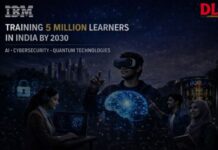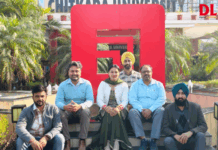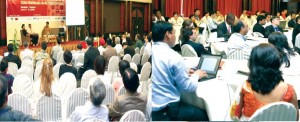 As Asia prepares to surge ahead towards information driven economy, leading to large-scale improvements in GDPs of many countries, there are new opportunities created for expanding the sector. Digital Commons explores three key areas, viz., access to knowledge and culture in Asia, exploring models for collaborative knowledge and culture in Asia and conceptualising a healthy digital commons. There has been much discussion on the role and impact of copyright and patent issues for the past few years both at the micro and macro level of economic activity. Copyright and patent issues are forms of intellectual property. Copyrights grant exclusive rights on expressive forums of ideas and information for a limited time while patents grant exclusive rights on processes for a limited time. Patents, particularly software and business process patents are currently not valid in most Asia-Pacific countries, but are very relevant considering what may or may ot affect a healthy Asian digital commons. The need of generating more discussion to gain increased understanding of the effects of software patents led to a consultation called, Asia Commons, the Asian Conference on the digital commons which was held in Bangkok, Thailand from 6-8 June, 2006. Asia Commons was organised by Bellanet Asia (a Partnership of SAP International and Bellanet), Bellanet Conference Report International, Centre for Science, Development and Media Studies, and UNDP APDIP’s International Open Source Network (IOSN) along with some local partners like Asian Institute of Technology and Thai Rural Net and funding partners like International Development Research Centre’s Pan Asia Networking and UNDP APDIP’s IOSN. The platform that brought together some 130 researchers, advocates, practitioners and custodians of public information from Asia Pacific and all around the globe, contributed tremendously in terms of increasing nderstanding of the effects of copyrights and patents, specifically software patents on access to knowledge and culture in Asia, identifying information gaps, conceptualising and enhancing partnership models for wider dissemination of knowledge and decision making. The face-to-face meeting was preceded by a highly participatory planning of the issues and a three eek online consultation was held to build a collective understanding of the contemporary issues and to familiarize oneself with the kind of participation. Three papers were commissioned out of an open call for
As Asia prepares to surge ahead towards information driven economy, leading to large-scale improvements in GDPs of many countries, there are new opportunities created for expanding the sector. Digital Commons explores three key areas, viz., access to knowledge and culture in Asia, exploring models for collaborative knowledge and culture in Asia and conceptualising a healthy digital commons. There has been much discussion on the role and impact of copyright and patent issues for the past few years both at the micro and macro level of economic activity. Copyright and patent issues are forms of intellectual property. Copyrights grant exclusive rights on expressive forums of ideas and information for a limited time while patents grant exclusive rights on processes for a limited time. Patents, particularly software and business process patents are currently not valid in most Asia-Pacific countries, but are very relevant considering what may or may ot affect a healthy Asian digital commons. The need of generating more discussion to gain increased understanding of the effects of software patents led to a consultation called, Asia Commons, the Asian Conference on the digital commons which was held in Bangkok, Thailand from 6-8 June, 2006. Asia Commons was organised by Bellanet Asia (a Partnership of SAP International and Bellanet), Bellanet Conference Report International, Centre for Science, Development and Media Studies, and UNDP APDIP’s International Open Source Network (IOSN) along with some local partners like Asian Institute of Technology and Thai Rural Net and funding partners like International Development Research Centre’s Pan Asia Networking and UNDP APDIP’s IOSN. The platform that brought together some 130 researchers, advocates, practitioners and custodians of public information from Asia Pacific and all around the globe, contributed tremendously in terms of increasing nderstanding of the effects of copyrights and patents, specifically software patents on access to knowledge and culture in Asia, identifying information gaps, conceptualising and enhancing partnership models for wider dissemination of knowledge and decision making. The face-to-face meeting was preceded by a highly participatory planning of the issues and a three eek online consultation was held to build a collective understanding of the contemporary issues and to familiarize oneself with the kind of participation. Three papers were commissioned out of an open call for
papers, and they brought together an in-depth analysis of the state of affairs of the issues. These papers were shared and a peer review process was set in motion to improve the understanding of the issues. Authors Junseok Hwang and Choong Hee Lee wrote about managing the Internet digital commons, resolving the dilemma of intellectual property in cyberspace. Vijayalakshmi Balakrishnan brought an Asian Historical perspective of mediating access, and lessons that can be learnt from it. Hsin-I Huang and Tzu-Chiang Liou focused his research on the benefits of collective innovation and looked at the question,  “Why Open Source Software?” While Peter Drahos from Australian National University and Jamie Love from Consumer Project on Technology presented keynotes at the start of the Asia Commons, the sessions proceeded discussing themes like history of commons, evolution of copyright, emergence of the digital economy, copyright and information gray economy, open business models for content production, and collaborative models speed sharing where the participants had the opportunity to exchange their experiences in developing, adopting or adapting new or existing models for collaborative knowledge and content creation. Lawrence Liang of Alternate Law Forum spoke about the cultural flows represented by the piracy of films and music in Asia and the need to move away from knee-jerk media responses to piracy, and Ronaldo Lemos of FGV School of Law spoke of the pioneering efforts by those who are experimenting with new ways of distributing knowledge and creativity in Brazil. Some incredible commonsbuild rs also shared their views in the conference like Michel Bauwens, who has developed one of the most comprehensive directories of resources on ‘peer to peer sharing’ at p2pfoundation.net and Patcha from Jinbonet who, together with an organization called IP Left in Korea, developed a cartoon campaign against the IP chapter in Korea-US Free Trade Agreement negotiations. The different conference sessions were hosted by Sunil Abraham of IOSN, Shahid Akhtar of UNDP’s Asia- Pacific Development Information Programme, Laurent Elder of IDRC Pan Asia Networking, and Ronaldo Lemos of Fundação Getúlio Vargas (FGV) School of Law. In an unique attempt participants were invited at the end of all presentations to co-create the agenda for the remainder of the Asia Commons conference. A two-day long discussion on the theme ‘Towards a healthy Asia Commons: What are the ideas and issues’ brought the opportunity for the participants to convene around topics of shared interest. They were invited to initiate ideas that they would like to take one step further through discussions with potential collaborators. Asia Commons created many opportunities where deep discussions and exchanges happened between the organisers and the participants who have experience and ideas that are relevant to the conference. A number of thought leaders in the field of Access of Knowledge culture looked to innovative approaches to share the knowledge. The conference outputs are disseminated through several channels like pod casting, blogging and through bringing out a special magazine issue of i4d, the first monthly ICTD magazine in Asia, in July 2006. The energy and enthusiasm created during the conference lives on with collaborative post conference activities taken up by the participants n the wiki (including creating an entry on Asia Commons), in discussion lists and over 20 new collaborative project ideas.
“Why Open Source Software?” While Peter Drahos from Australian National University and Jamie Love from Consumer Project on Technology presented keynotes at the start of the Asia Commons, the sessions proceeded discussing themes like history of commons, evolution of copyright, emergence of the digital economy, copyright and information gray economy, open business models for content production, and collaborative models speed sharing where the participants had the opportunity to exchange their experiences in developing, adopting or adapting new or existing models for collaborative knowledge and content creation. Lawrence Liang of Alternate Law Forum spoke about the cultural flows represented by the piracy of films and music in Asia and the need to move away from knee-jerk media responses to piracy, and Ronaldo Lemos of FGV School of Law spoke of the pioneering efforts by those who are experimenting with new ways of distributing knowledge and creativity in Brazil. Some incredible commonsbuild rs also shared their views in the conference like Michel Bauwens, who has developed one of the most comprehensive directories of resources on ‘peer to peer sharing’ at p2pfoundation.net and Patcha from Jinbonet who, together with an organization called IP Left in Korea, developed a cartoon campaign against the IP chapter in Korea-US Free Trade Agreement negotiations. The different conference sessions were hosted by Sunil Abraham of IOSN, Shahid Akhtar of UNDP’s Asia- Pacific Development Information Programme, Laurent Elder of IDRC Pan Asia Networking, and Ronaldo Lemos of Fundação Getúlio Vargas (FGV) School of Law. In an unique attempt participants were invited at the end of all presentations to co-create the agenda for the remainder of the Asia Commons conference. A two-day long discussion on the theme ‘Towards a healthy Asia Commons: What are the ideas and issues’ brought the opportunity for the participants to convene around topics of shared interest. They were invited to initiate ideas that they would like to take one step further through discussions with potential collaborators. Asia Commons created many opportunities where deep discussions and exchanges happened between the organisers and the participants who have experience and ideas that are relevant to the conference. A number of thought leaders in the field of Access of Knowledge culture looked to innovative approaches to share the knowledge. The conference outputs are disseminated through several channels like pod casting, blogging and through bringing out a special magazine issue of i4d, the first monthly ICTD magazine in Asia, in July 2006. The energy and enthusiasm created during the conference lives on with collaborative post conference activities taken up by the participants n the wiki (including creating an entry on Asia Commons), in discussion lists and over 20 new collaborative project ideas.
Asia Commons: The Asian Conference on Digital Commons
Accessing e-Content
This article focuses on the creation and benefits of a wireless network in the university setting that connects four universities and several companies in the Turku-region, Finland. The key aspects of this innovation network – SparkNet, which is one of the world’s largest wireless networks is illustrated and a framework is used to analyse the benefits of the network in the teaching context. SparkNet can be used in various ways to support and augment both traditional and distance teaching. The illustration is made on how an innovation affects the contexts of both teaching and e-learning
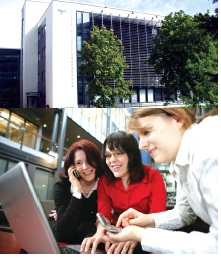
Sparknet is one of the world’s largest Wireless Local Area Network (WLAN) is a tool for university education, in a business school setting through interaction
with other university organisations and external experts.
SparkNet
Turku is the oldest city and former capital of Finland, locating in the south-west corner of the country. At present it is the fifth largest city in Finland. There are
three universities (University of Turku, Abo Akademi University, Turku School of Economics and Business Administration) and the Finland’s largest polytechnic in Turku. The university sector has 25,000 students and 400 professors. The city of Turku is concentrating on two main industries, namelyICT and biotechnology. Turku Science Park is a combination of university, industry (strong focus in start-up companies) and research related organisations developing the ICT and bio industries. SparkNet is an innovative concept, where existing networks (LAN) are used in collaboration with otherexisting networks to create a contractual-based wireless network. For the user SparkNet enables him/her to access his/ her own network and its resources (intranet, real email, file servers etc.) via other networks, which are members of the SparkNet concept. The innovation behind SparkNet is not developing new technology but to take advantage of existing infrastructure and provide customers with a service innovation meeting the real use contexts. The
features of SparkNet:
• Secure and free access to one’s own intranet through SparkNet (email, calendar, data access own servers)
• About 1300 access points (as of March 2006)
• Over 100 000 user accounts o University staff (three universities in Turku, one polytechnic) and students o Municipalities (public offices, libraries)
o Government offices (for example the Turku City council is now paperless –
they use laptops) o Private companies as users o Private companies as
SparkNet service providers (restaurants, cafés, yatching clubs, hotels)
o Roaming agreements with a number of Finnish universities
• Access through one’s existing user accounts (excluding visitors)
• Flexible infrastructure and user account management (visitors can join the network with an access code)
• Support for multiple devices (computers, laptops, mobile phones, PDAs etc.)
• Easy usage, no dedicated hardware or software required
SparkNet components:
1. Access points
2. Spark Virtual LANs
3. Authentication gateways
4. Dedicated routers connecting Spark VLANs
5. Operator selection service server Network Facilitated Learning Framework
The framework consists of three main aspects, namely digitisation, interactions and transactions. Digitisation The key issue here is that whatever can be digitised, has certain properties like it is usually costly to produce, the copying costs of it are near zero and it is easily transferable through networks. The focus should be in the application of information within the organisations; both in terms of its use as a source of value added for existing processes and to the extent it can enhance those processes.
• SparkNet offers access to own digital content while out-ofoffice. It also allows access to any electronic data sources (elibraries, large on-line business
data-bases etc.), which require access rights. Thus, it also helps in creating and sharing new digital information/knowledge.
• Same applies in the creation of new digital products/services. For instance, start-up company focused training can be partly moved to the digital domain.
Transactional Approaches There are two variations of transactional approach. The first one, called hierarchical approach, has a very strong focus on minimising transaction costs and strengthening or retaining power relationships within the organisation and with other organisations. The second variation is called co-operative transactional approach.
• SparkNet fulfils the traditional role of ICT in increasing efficiency without changing any hierarchical structures (i.e. the universities continue their operations the normal way, but increased access possibilities for staff and students for example raise efficiency)
• SparkNet offers totally new ways for co-operation between universities (and companies). For instance, access to own digital content (e-mails, documents etc.) while visiting other universities makes teaching and meetings more efficient. Interaction-based Approach Interaction can be communication or
using an interactive system, but the important aspect is that what is conveyed during the interaction is in digital form or interaction is assisted by digitisation.
• SparkNet offers both efficiency in interacting with traditional partners as well as a new interaction channel for previously separate organisations, such as
universities and start-up companies. Facilitating learning in a modern way
SparkNet can be used in various ways. In creating a learning
Recognising e-Content
The information society will remain an empty concept if one talks solely about technology, network and access issues. Considering the general use or impact of the information is meaningless, unless we carry the messages, which those can translate. The World Summit Award (WSA), the global initiative to select and promote the world’s best e-Content, looks into this aspect of technology for which, it is a global hub for everyone today. As of today, 168 countries are actively involved in WSA. By selecting, presenting and promoting the best products from all over the world in that field, it makes a contribution to bridging the Digital Divide and narrowing the Content Gap. The World Summit Award will hold the Grand Jury for the selection of the World’s Best in e-Content in Croatia in 2007.
Connecting this global platform to the fact that India is one of the poor countries in exposing its content using digital media, and its information assets are still weekly represented, a parallel process, Manthan award for best e-content practices in the framework of WSA started recognising the Indian ventures which speak less of the technology and more of the usage for final delivery. The best econtent practices in India for 2006 recognised by Manthan Awards is going to be announced this August. Such initiatives recognising the contents will open doors for global recognition and support to the local initiatives, understanding the fact that e-content will enable every citizen to become self-reliant on the basis of information prowess .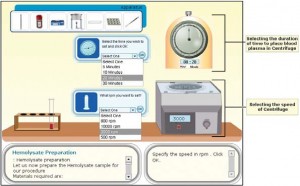
Designing Virtual Labs
Hilmi Quraishi [HILMI@ZMQ.IM], ZMQ Software Systems, India
The advancement in educational technology and tools have unleashed the opportunity to take e-learning and e-content to the next level by delivering complex concepts and scientific processes, which are often not easily rendered in words, into virtual laboratories and simulated systems. Theoretical and
scientific concepts are converted into dynamic, engaging and effective content using simulations. Instructionally, simulation makes a process easier to understand, increases retention of information, and helps build skills and competencies by letting learners understand complex scientific processes. The instructional design strategy to develop virtual laboratory combines learning theories, e-learning experience, technological innovation, and visualisation.
Instructional Strategies
Learning theories have significant bearing on instructional design, as there is a logical development from learning to instruction. Instructional design optimises learning outcomes while learning theories are the backbone of any instructional design. The three basic schools of learning theories, namely Behaviourism (changes in behaviour as the outcome of learning), Cognitivism (learning occurs when learners add new concepts and ideas to the cognitive structure) and Constructivism (learners construct knowledge for themselves) have their own implications for instructional design.
Key Implications
Learning theories and models have different implications for instructional design. While designing instructional strategies, inspirations must be taken from variety of instructional theories and models. For learners, some of the key implications of virtual laboratories and scientific based simulated systems are: Quicker and Easier Learning, Mastery of Content, Problem Solving Approach, Provide Feedback to einforce Performance, Participation in Learning, Adaptive Learning Approach, Promote Scientific Thinking, Project based Learning, Situational Learning Environment, Address Multiple Learning Styles
A Virtual Experience
With the spread of Internet access, it is now possible to offer students virtual laboratories through the World Wide Web. The idea of developing a virtual laboratory is to train the students as many number of times as possible. The students are exposed to the real laboratory, where they go through the experiment once. Virtual laboratory is distinguished from a real or a traditional laboratory. However, virtual laboratory is not viewed as a replacement for a real laboratory. nstead, virtual laboratories are possible extensions to real laboratories and open new opportunities not realisable entirely within a real laboratory at an affordable cost.
A case study
Virtual laboratory Electrophoresis e- Lab was designed to train medical students and technical trainees in clinical laboratory on Electrophoresis experiment. Electrophoresis is an analytical method frequently used in molecular biology and medicine, and is applied for the separation and characterization of sub-cellular sized particles. The objective of the experiment is to observe different band patterns and interpret results of various samples of normal and clinical conditions. The main idea of the virtual lab is to create a real lab environment using scripted model with controlled animations. It is not just demonstrating a process using animations, but rather developing programmatically controlled scripted simulations using animated components. Some of the labs can be viewed at the link: http://www. zmqsoft.com/elearning/home.htm An example of virtual lab is presented here. The simulator also tracks the performance of a user. It monitors different steps taken during the course of experimentation, number of attempts taken to complete it successfully, and provide results of all experimental input values with feedback. The idea is to create an environment for learner, where the learner practically experiments the processes by changing different input values and parameters.
Key Components
Besides developing a simulated learning environment, the e-Lab is also supported by other different learning components to give a complete learning solution to the learners. The key components are- Pre-Test: It prepares learner for the next stage of learning by stimulating the recall of prerequisite nowledge. Pre-test is an essential for creating adaptive learning environment.
Theory: The content theory provides with detailed description and explanation of concepts, rules and principles for clearer understanding. It comprsies of different case studies, examples, non-examples and simulated diagrams for quicker understanding. Interactive Exercise: Various practice exercises like multiple choice questions, single choice questions,. drag-and-drop, match-the-following, filling-in-the-blanks etc; allow the learner to practice opportunities to aid in retention of information and creation of knowledge. Feedback: The feedback encourages the learner to improve thinking and understanding of the problem. The feedback for an incorrect response should provide the correct answer for the learner in an effort to improve future performance. Post Test: It is used to assess the performance of learner and new knowledge that has been integrated correctly. Often, educational technologists also use post-test values to make corrective measures in their learning environment. Other Components: Other important components of a complete virtual learning environment are glossary, FAQs, help, know-more etc. to provide complete support during process of learning. Virtual labs have opened up new opportunities at an affordable cost. Experiment-oriented problems can be offered without the overhead incurred to experimentation, problem solving and data gathering
Managing e-Content
Often time and support for implementing
an effective online e-learning system is underestimated. The environment and cultural background of students and instructors are often neglected and not understood. These results in many portals
reducing to a mere depository site where
students log on to download traditional
notes prepared by nstructors. This article
proposes a structure of the cooperative e-learning portal, based on an e-learning management system. The structure focuses on instructor and student centric active learning where students not only learn from their dedicated instructor but have the opportunity to share and learn from a pool of instructors and even students.
All researchers and content developers may be students and instructors at one point in time but not all content developers are instructors and students at the same time. Not many instructors are content developers, they may be content
providers also. This mismatch has hindered the widespread adoption of e-learning to the chagrin of the e-learning managers and implementers. As a result of this, many e-learning setups has been reduced to merely a depository portal – instructors uploading their existing Word, PDF or power point files for
students to download and thus has not released the real potentials of
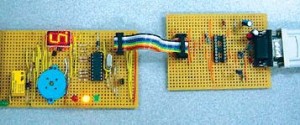 Problems of existing e-learning setups
Problems of existing e-learning setups
Many e-learning setups have been introduced in schools, tertiary institutions and organisations because of various reasons. Often the measurement of success in such adoptions are through the portal access volume statistics which is flawed, statistics does not reveal the satisfactions of the students and
instructors for such system nor it reveals much of the online learning experience. The environment and cultural background of students and instructors are often neglected and not understood. Supports and time for implementing an effective online e-learning system is often underestimated. Trainings, where provided to instructors, may not be effective because of time constraints and the steep learning curves of elearning development tools for non- IT personnel. All these results in many portals reduced to a mere depository site where students log on to download traditional notes prepared by instructors. Besides, third party content development is expensive and very often educational institutions are reluctant to spend or have very low budget for this. Requirements for performance and costs often contradict each other,
which may lead to user frustrations and disillusion for e-learning.
Cooperative e-learning portal
In this section, the proposed structure of the cooperative e-learning portal, based on the e-learning management system, ecLEMS (http://www. ecpresence. com), is presented along ith some illustrations on the logics and the benefits of such portal. Cooperative e-learning is about instructor and student centric active learning where students not only learn from their dedicated instructor but get the opportunity to share and learn from a pool of instructors and even students in a portal designed for sharing. The portal is organised under a broad umbrella of a learning centre where a group of schools or institutions conducting similar courses are signed up as partner members. All partner members can create courses on the portal for their own pupils organised in classes. Other members can join the course and share information created for the course by creating their own classes under the course. While information is shared in the background, students and instructors from members retain their own identity throughout the learning experience. In this way, instructors are not required to prepare every single content themselves but can focus on tackling what they do best – teaching and guiding the students. Content and materials come in various forms. The most important ones are the teaching materials. These can be in the form of simple power-point
slides, word documents or PDF files, flash or other interactive programmes, proprietary designed contents and even interactive simulators using Java Applets and others. These types of contents are expensive to write and develop and therefore it makes sense that it should be reached out to more users to share out the costs. Another area of learning materials is in the form of teasers,
quizzes and assignments. Instructor members can contribute to the pool by uploading them to the central bank under some defined common topics for the course that can be setup by instructor members themselves. With the aterials in lace, instructors and students can then benefit from these contents to embark on a more meaningful active learning with the built-in interactive tools. Interactivity depends very much on the cultural makes of individuals; some are more reserved while others are more ready to participate in group discussions. Hence, the portal caters to this diversity of student groups to bring them up gradually to the public discussion forum. Instructors can start by using the more private short message service (SMS) system to get the students to open up leading them to the public forum. Assignments and projects form one of the very important processes of learning. The portal provides an interactive feature for instructors to setup projects and assignment for students to submit. Instructors can then give feedback to individual students on their progress and make comments while the system will keep the parties involved and informed through emails. All these activities could be easily setup by the instructors and the students informed through the Announcement as shown in the image or the Planner system. Students could learn from their fellow classmates through the user pal system, ecLEMS Pals where students can seek out other users of the portal for discussion and friendship. In recent years, this form of interaction has generated a lot of interests by Internet users and this forms an important tool for online learning.
Students can form study groups to experience online interactive learning with other fellow users of the portal. The world-wide-web is more than a global network. It is a network of intelligent machines capable of not only fast computational activities but also a major resource of contents and content delivery. The proposed system taps onto these resources to create not just a standalone portal but a global integrated network of resources and servers to form a global e-learning portal. Partner members and individual users need not upload the contents onto the portal. They only need to register the contents to be used by students with the central portal server. The central server will keep track of the content information and the source computer server. Users will be channel to the appropriate resource to render out the content when requested through the portal. In this way, hardware resources as well as bandwidth
resource can be distributed over the global portal.
Case studies for interactivelearning using the proposed system
Two cases will be presented here to demonstrate the benefits of the proposed system. Case 1: The first involves the teaching of embedded or micro
controller system with hands-on Assignment project is then setup for students to carry the programming and loading onto the hardware. Throughout the project, students can submit the project progress report weekly through the project assignment page. Instructors can feedback and interact with the students by making comments on the project as it progresses. To mitigate instructors’ burden in tracking submission, emails are sent by the system to the instructors whenever students submit their reports. Similarly, students are
prompted when comments by instructors are submitted. Case 2: In this application, students were involved in an industrial attachment either locally or while in another country. Students are required to submit bi-weekly reports for the supervisors, one from the organisation where the student is attached to and the other from the institution, for record and assessment. The institution
supervisor or the instructor is often required to make appointment with the organisation supervisors and students for meetings. To ensure the students have a beneficial attachment, the instructor can feedback to the students through the portal based on the bi-weekly reports that he submitted. Every
single entry by the students and the supervisors are logged and can be easily retrieved and the parties involved informed through email whenever there is
a new update. In addition to the necessary close interaction between the instructor and the student in an online active learning environment, peers interaction is also necessary to set up the right cultural mode for a successful e-learning setup. The ecLEMS portal has demonstrated to have these features necessary to build upon a global e-learning portal.
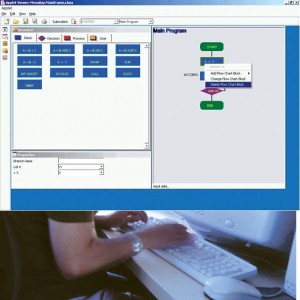 Interactivity depends very much on the cultural makes of individuals; some are more reserved while others are more ready to participate in group discussions. Hence, the portal caters to this diversity of student groups to bring them up gradually to the public discussion forum.
Interactivity depends very much on the cultural makes of individuals; some are more reserved while others are more ready to participate in group discussions. Hence, the portal caters to this diversity of student groups to bring them up gradually to the public discussion forum.
experience using an online Applet programmer, called PicWorks. A copy of the Applet view is shown above where users make use of a graphical tool to programme real-time system using ow-chart. Users make use of the interactive programme for the rogramming and debugging of the controller and subsequently uploading the binary programme onto the hardware for the final test. Students’ interests are upheld through the use of a web-cam to feedback to them the fruit of their ard work. At shown in the figure of the web-cam feedback image. First instructor can upload the content as power-point files, video such as the CoreChart and eRacer Project or talking head content for the formal teaching of micro controller.
Localising e-content
In an attempt to address the relative absence of interactive online learning environment in Indian languages, Vartalaap was  conceived, which supports instant messaging in Indian languages to cater to the communication needs of people in their local language. The Vartalaap Virtual Classroom system enables a teacher or subject-expert to conduct live interactive consultancy sessions with a group of students over a computer network. The system can integrate with text-to- speech systems in Indian languages to augment usability and can be a very useful support tool in academic environments especially in distance education to assist teachers to reach a wider group of students, who may be physically in different locations, thus making interactive online education possible.
conceived, which supports instant messaging in Indian languages to cater to the communication needs of people in their local language. The Vartalaap Virtual Classroom system enables a teacher or subject-expert to conduct live interactive consultancy sessions with a group of students over a computer network. The system can integrate with text-to- speech systems in Indian languages to augment usability and can be a very useful support tool in academic environments especially in distance education to assist teachers to reach a wider group of students, who may be physically in different locations, thus making interactive online education possible.
Web based education and e-learning are the trends of the day. The education scenario in India is on the threshold of a significant change in the way education is delivered. There are many educational institutions that offer higher education courses via distance education. Students of distance education courses typically receive study materials and assignment handouts via post, and send back completed assignments via post to the distance education centre. The students have limited facility for interaction with peers and expert teachers for clearing doubts and getting feedback on assignments and this diminishes the learning outcome. The Vartalaap Virtual Classroom System is a computer-based solution designed to cater to the need for real-time communication between teachers and students for tutorial sessions.
What is Vartalaap Virtual Classroom?
The Vartalaap Virtual Classroom System is a computer-based solution over a computer network that creates an environment modeled closely on a real-world classroom. Teachers and students come together in such an environment for having live interactive discussions for sharing knowledge in any subject. Teachers and students communicate in real-time via instant messaging, and the expert can use tools like the virtual whiteboard and presentation window for explaining a subject matter. The teacher can moderate classroom communication and thereby enforce general discipline among the participants in a virtual classroom session.
System Components
Vartalaap has client-server architecture. Vartalaap clients run the Virtual Classroom Desktop. Many front-end clients can connect to a Vartalaap Server over a TCP/IP network. A teacher connects as one of the clients and initiates a virtual classroom session. Students connect as other clients into the same session. The Vartalaap Server manages all communication between the clients.
The server can manage several virtual classroom sessions, each with its own group of registered participants. Vartalaap client and Server are designed to run on all operating systems that support Java. Virtual Classroom Desktop A Vartalaap Client displays the virtual classroom desktop which consists of several tools – instant messaging windows, presentation window, virtual whiteboard, file transfer tool, and classroom control panel all composed in a user friendly intuitive graphical interface. A teacher initiates a virtual classroom session and students pre-registered for the session are permitted to join the session. Instant Messaging Windows Live communication between the
teacher and students in a virtual classroom session is supported by instant text messaging facility. Each participant in a virtual classroom session has a write-enabled message window through which he/she can send text messages in real-time to other members in the session. A readonly message window displays all user messages exchanged in a session in chronological order. The user has the option to filter messages in the view message window by user name. Students and teachers can use the instant text messaging facility for live
question-answer discussions in a session. The system allows several forms of communication such as oneto- many (default mode) wherein a message sent by one member are received by all others in the session, and more restricted forms such as one-to-one communication and conferencing for group communication. Students can use the conferencing facility for group discussions. The system provides controls for a teacher to dynamically control the messaging facility access rights of all other members in a session. Vartalaap supports instant text messaging in Indian languages in addition to English. The multilingual facility will be very useful for providing access to education to a wider group of students many of whom may be in rural areas where local language is the primary medium of communication. Presentation Window In a traditional face-to-face classroom session, a teacher will present and explain some subject matter through slides or by writing on a blackboard or whiteboard. In Vartalaap, these functions are supported via the presentation
window and the virtual whiteboard. The presentation window is used for displaying subject content such as slides or a document in a virtual classroom session. Currently the system allows presentation of any content compiled as a set of images or plain text files. The teacher controls what to show in the common presentation window. The teacher can control the flow of the presentation such as walkthrough the presentation step-by-step and all student views are synchronised with the teacher’s presentation window view. The teacher can highlight and make annotations in the content during the presentation. The highlights and annotation markings internally do not affect the original content. Vartalaap provides the facility for a teacher to package courseware resources and upload to the server for use in a virtual classroom session. The courseware is automatically downloaded to Vartalaap client machines when members join a session.
Virtual Whiteboard
The virtual whiteboard is used for writing text and making drawings – freeform and/or structured drawings like circle, rectangle, ellipse, etc. in a session. By default, only the teacher has privilege to write or draw things in the virtual whiteboard.
Classroom Control Panel
The classroom Control Panel displays the names of all users connected in a virtual classroom session. All members view the classroom control panel, but teacher and student roles have different functions enabled in the panel. The classroom control panel provides controls to enable/disable a user’s access to the virtual whiteboard, presentation window and text messaging facility. The teacher can also terminate any member’s session. If a student wishes to have access to any communication facility, he/ she is required to use the hand-raising facility to notify the teacher. The teacher’s classroom control panel gets instant notification of hand raising requests from students and the teacher can selectively allow access to the different facilities. Polling is another interesting feature, wherein a teacher/moderator can raise a question for all the students/ participants to answer. The poll can answer such as yes-or-no or true-orfalse or it can elicit a descriptive text reply. Timeout and word limits can be set for the reply to poll. The poll results are presented in a separate window. A teacher can use polling feature for various purposes such as to gauge the level of understanding of subject matter during a session, conduct a quick short quiz or obtain student feedback on any issue.
Vartalaap supports instant text messaging in Indianlanguages in addition to English. The multilingual facility willbe very useful for providing access to education to a widergroup of students many of whom may be in rural areaswhere local language is the primary medium of communication
Other Vartalaap Services
The system supports file transfer between users during a session. This may be used by students to send assignment solutions to the teacher. The system provides classroom management functions like class module creation, session scheduling, and registration of class participants. Vartalaap maintains a user profile for every registered user. The profile contains user’s contact details, login details and virtual classes’ registration information. The system provides a Bulletin Board for publishing classroom session schedules and general notices from the Vartalaap system administrator. Vartalaap supports logging and replay of virtual classroom sessions. A member interested in a particular session can replay it, if he/she has missed participating in the session. The logging facility for virtual classroom sessions records all communication that occurred in the presentation window, whiteboard and messaging facility in a session. The replay facility can replay all recorded session communication in same order, with pause/resume controls. Vartalaap virtual classroom desktop
can also interface with text-to-speech systems so that text messages received can be read out to a user. The user can selectively enable this facility for messages received from specific users so as to draw attention when a particular user has responded.
Vartalaap Server
Vartalaap clients communicate with the Vartalaap backend Server using TCP/IP protocol. IRC protocol is used for text messaging and custom extensions have been defined to handle other communications in the virtual classroom. Vartalaap backend services are provided by a group of collaborating servers namely Communication Server, Profile Server, Log Server and File Transfer Server. Communication server is responsible for handling user communication. Profile Server manages user profiles. Log Server manages session logging and services session replay requests. File Transfer server is responsible for coordinating various file uploads and downloads in the system. User profiles, classroom session information, and session logs are
stored in a relational database. Vartalaap virtual classroom system can be viewed as a lightweight synchronous e-learning facility. It is well suited for use as a supplementary education facility for conducting online tutorials especially in distance education. It can also be used for online counseling. It works well over low bandwidth network. It supports use of Indian languages for text communication, therefore can be used by a wider group of teachers and learners.
Euro-Southeast Asia 2006 Co-operation Forum on ICT
Back in July 2003, European Commission (EC) initiated a communication  programme with South East Asian nations on ‘New Partnership with South East
programme with South East Asian nations on ‘New Partnership with South East
Asia’. The programme was envisaged as a strategic move to establish active dialogue and business relations between the two regions for development of the emerging information society and knowledge economy. Under the aegis of this programme, European Commission for Information Society and Media and the Association of Southeast Asian Nations (ASEAN) jointly organised the uro-Southeast Asia 2006 Cooperation Forum on Information and Communication Technologies (EUSEA 2006) conference from 19th- 20th June 2006, at the luxurious Shangri-La Hotel in Singapore. With more than 500 participants coming from various parts of Europe and Southeast Asian nations, the event provided a perfect setting for people to learn new initiatives, understand each other’s interest, share knowledge and mobilize partnerships. Opening the main conference, Viviane Reding, European Commissioner for Information Society and Media emphasized the crucial need of a serious collaborative platform for encouraging governments, industry and research institutions of EU nations and Southeast Asian (SEA) nations to forge advanced ICT research, technology development and joint projects deployment for ushering into the modern information society and knowledge economy. In her speech, Mrs. Reding urged SEA nations to open up their economies, under the rationale of the huge Conference Report intellectual and economic benefits that it brings in. She assured of best possible cooperation and support from her Commission in making such initiatives to be successful. Some of the other speakers of the opening session of the conference were – His Excellency Ong eng Yong, ASEAN Secretary-General, Mr. Shankar Iyer, President, European Chamber of Commerce, Singapore and Senior Minister of State, Ministry of Information, Communication & Arts, Singapore, Dr. Balaji Sidavasen. All of them highly appreciated the initiative of EU and ASEAN in creating a collaborative platform for knowledge sharing and business partnership. The keynote session that followed brought together a power panel of eminent scientists, researchers and industry leaders from Europe and Southeast Asia, who reflected on key ICT initiatives, interventions and innovations undertaken by their respective agency/enterprise. Power packed presentations of speakers from the ICT industry, (namely Tim Cowen of British Telecom and Jean- Claude Marquet of ST Microelectronics) was seamlessly placed with insightful deliberations of David West, Project Director, DANTE nd Dr. Thaweesak Koanantakool, Director of National Electronics and Computer Technology, hailand. Each with their unique set of knowledge and expertise brought forth whatever is latest and cuttingedge in their own domain. The remaining one and half days of the conference had 36 parallel sessions, comprising 24 technical sessions, 6 training workshops and 6 networking sessions. The technical sessions focused on a variety of issues relating to technology, applications, egulatory and policy framework, research etc. Training sessions of the event conducted by experts from the European Commission proved to be very helpful and informative for those looking for business collaborations and research funding for advanced R&D in the field of information systems, communications and technology development. The networking sessions titled – ‘Get in Touch’, provided an ideal setting for people to know each other and about their initiatives in an informal, yet, in a facilitated environment. The sessions were designed with an objective to create opportunity for general participants to deliver brief presentations and overview of the technology, application or research they are working on and involve the audience in an open discussion on technological, commercial and social feasibility of their products and solutions.
Content is King!
Successful learning requires effective and engaging learning content. Today one of the biggest challenges to the successful learning through ICTs is the lack of relevant e-Content. e-Content or ICT-based content are education and instruction content in the digitized or electronic form. Today the definition of e-Content has expanded to include all learning aids that can be delivered through the various ICTs tools– computer, radio, television, PDA, mobile phones and other. . Though the definition of e-Content has broadened, the availability of this content, both online and offline, computer-based or radio- based, still remains a challenge for most developing countries. While the challenge of availability of relevant e-Content is perpetual, the availability of this content does not necessarily assure access to this content. Again, there is a general lack of knowledge and awareness about existing and available content. There have been very few initiatives to map the existing content and even fewer researches to integrate the available content into a national ICT in education initiative. The challenges do not end here. Experts argue that in the top ten inhibitors to the use of ICT in education, the first two would be language and cost. This is true for e-Content too. Again, management of this content, making the same available and sharable to a number of users, understanding the intellectual property issues of content and finding alternatives, and most important learning content to be in line with the education objectives of the country, are just some of the challengesthat need to be addressed, if learning through ICTs are to be made effective. In this respect, the role of national and international networks assumes great importance. The Global e-Schools and Communities Initiative (GeSCI) has initiated the creation of a web-portal that will make available a critical mass of educational content to the education community especially teachers and practitioners. In India, Indian Institute of Technology (IIT), Bombay, and IIT, Kharagpur is developing a multi modal participatory content repository for the education of rural children. There is a need to develop standards following which the right e-learning content can be created and another set of guidelines that can help policy-makers and practitioners to evaluate content to ensure that it meets the pre-defined educational objectives and identifies key strengths or gaps. Tools need to be developed that will help developing countries access education content. There is also a need for a clear ICT in Education policy that promotes and guides the creation of relevant ICT-based content. In this issue of Digital Learning, we are pleased to bring the perspectives on e-Content, and in an upcoming issue we will be focussing on the policy framework in ICT in Education. Do look out for our special thematic issues and the upcoming conference specials in the next few months.
India schools to SMS parents on homework and fees
Schools in India will soon start sending SMS to parents on practically everything – from sending exam alerts, marks updates and fee dues.
The same facility will be available on the website too. Each child will be allotted a unique ID which will enable the parent to log on to the website www.mylyceum. net and get the latest on their wards. Students, too, can register. More than 60 schools in Bangalore, including Bishop Cotton Boys & Girls Schools, Sophia High School, Frank Anthony Public School and Cathedral School, have tied up with Pac Soft Solutions Ltd to offer this facility. Schools will post the information on the portal. There'd be options whereby parents could receive an SMS which would be a reminder to go to the website and access complete information. Or an entire message is sent on SMS itself like declaration of results or about a new circular. This would allow parents to get the whole message on the move, without having to visit the website.
Drama school soon in Madhya Pradesh
The dream of Madhya Pradesh chief minister Shivraj Singh Chouhan to have a state-run drama school on the lines of National School of Drama (NSD) promoting folk theatre and others arts of central India has finally taken shape. Exclusive to promote theatre as a vocation, the first state government-run school will be inaugurated in Bhopal on June 17 by senior BJP leader L K Advani. Theatre personality Vani Tripathi, the Madhya Pradesh Drama School will offer one, two and three year courses. A batch of 25 students have been selected for the first course starting in July. Apart from courses in Indian classical theatre, modern Indian theatre and Western drama, the school will specialise in folk drama of Madhya Pradesh and Chhattisgarh, tribal dance and folk story tellers. “The focus of the school will be preserve, protect and restore the dying arts of Bundelkhand, Baghelkhand, Malwa and Nimaad and as well as cover modern areas like film and television,” Tripathi said. The school's advisory body includes theatre luminaries such as Bansi Kaul, Mahesh Dattani, Sanjna Kapoor of Prithivi Theatre, NSD director Anuradha Kapoor and natyashastra expert Kamlesh Dutt Tripathi.
New Zealand attracts Indian students with education fair
Parents with their children, groups of school-going teenagers and graduates sauntered through the stalls put up by 25 participating institutions and universities. 'I am here with my father and sister. I have brought along all relevant documents. I want to do a business management or accounts course. I like what I have seen here, I am definitely going if I get through, and they (the universities) say I qualify,' said Neha Mehta, a first year B.Com student. Neha, a resident of Ghaziabad, said she thought New Zealand was full of opportunity, and that she had worked out a basic plan with her agent here. New Zealand Trade and Enterprise (NTZE) and Education New Zealand Sunday organized the education fair in the capital hoping to woo Indian students with its niche set of courses and 'study – leisure environment.' The fair will also be held in Chandigarh April 7. Many present appeared amazed that New Zealand, perceived mainly as a tourist destination, could be an education provider interested in Indians students.
NZTE officials said that in the year 2005 there where 2,000 Indian students in New Zealand. The numbers have increased to 6,000 students as of March 2009. 'Education visas for New Zealand are fairly easy to get. In fact since most of the universities and institutes there communicate with students via our 21 local agents in India, the process of application is very simple,' said Jugnu Roy, NZTE business development manager. The fair also drew a lot of interest in niche courses like viti culture (wine tasting), hospitality management, plant science and horticulture, food technology and sports management. While New Zealand hardly offers any scholarships, officials said that low student living costs and higher standard of living in New Zealand will attract scholars from India.

